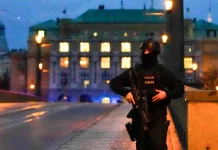The US held Hamas responsible for the collapse of a weeklong cease-fire in the Gaza Strip, where Israeli forces resumed airstrikes on Friday.
The White House said that Hamas failed to deliver a list of prisoners the group would release as part of the truce agreement. Israel and Hamas also gave different accounts of why the cease-fire fell apart.
“Hamas is the reason why this pause ended,” said John Kirby, the National Security Council’s coordinator for strategic communications. “They were simply unable to produce a list of prisoners that could facilitate the extension of the pause.”
President Joe Biden and the entire security council will continue to engage in diplomacy, Kirby said, as the US seeks another cease-fire and the release of more prisoners. Qatar, another international mediator along with Egypt, said it was working to restore the truce and expressed “deep regret” over the resumption of hostilities.
The Gaza Health Ministry, run by Hamas, said that at least 178 Palestinians were killed and dozens more wounded in the hours after the airstrikes restarted on Friday, and Israel said it hit more than 200 Hamas targets.
“It is up to Hamas to produce a list of prisoners that they can release so that we can try to get this pause back in place,” Kirby said.
Israel initially stopped the delivery of humanitarian aid to Gaza after restarting the airstrikes on Friday, but later allowed several dozen trucks of aid to enter at the request of the Biden administration, according to Israeli officials.
“If Hamas really cares about Palestinians, as they claim to do, they will do what they can to come up with a list of prisoners that can be exchanged so that the aid can keep flowing,” Kirby said.
Israel said it resumed the fighting after Hamas “violated” the cease-fire and fired rockets at Israel. Hamas officials blamed the Israelis, saying they rejected offers to release elderly prisoners and the remains of prisoners.
During Israel’s seven-day pause in the fighting in Gaza, more than 100 prisoners, all women and children including two Americans, were freed from Hamas captivity. Seven Americans, including one woman, are still missing. In exchange, about 240 Palestinians detained in Israel were released.
More than 13,300 Palestinians have been killed since the war erupted nearly two months ago, according to the Gaza Health Ministry. About 1,200 Israelis have been killed, mostly civilians during Hamas’ deadly Oct. 7 attack on Israel.
Developments:
- According to an Israeli government briefing, Hamas is holding 137 hostages as of Friday, comprising 115 men, 20 women and two children. Among them, 126 are Israeli citizens and 11 are foreign nationals.
- Kibbutz Nir Oz confirmed the deaths of three of its members who were in Hamas captivity, including the oldest hostage. The deceased are Maya Goren, 56, Arye Zalmanovich, 86, and Ronan Engel, 54.
- The Israeli army announced that it retrieved the body of Ofir Tzarfati, 27, who was presumed to be a hostage in Gaza. Medical officials identified the body and his family was informed of his demise on Wednesday.
- German Foreign Minister Annalena Baerbock urged the international community to pursue another cease-fire for the sake of “the remaining hostages who have been languishing in dark tunnels for weeks, and the afflicted people in Gaza, who desperately need more humanitarian aid.”
- Hezbollah, the militant group in Lebanon, claimed that it attacked Israeli troops along the border with Israel for the first time since the temporary truce between Israel and its ally Hamas started a week ago. Lebanese officials reported to the Associated Press that Israeli shelling killed two civilians in a village.
- Iran’s delegation walked out of the U.N. climate conference in protest over the presence of Israeli officials, state-run IRNA news agency said Friday.
- Médecins Sans Frontières, or Doctors without Borders reported that Al-Awda Hospital suffered damage in a blast hours after the truce ended. The organization said it is one of few functioning hospitals left in northern Gaza.
Airstrikes and rockets resume after truce ends
Israel launched airstrikes on Hamas targets in Gaza, shortly after a temporary truce ended. The Associated Press reported that Israeli jets hit a residential area east of Khan Younis and a house northwest of Gaza City.
Israel also distributed leaflets over southern Gaza, advising residents to evacuate and declaring Khan Younis a “dangerous battle zone.”
Meanwhile, rockets were fired from Gaza toward Israel, triggering sirens in several Israeli towns near the border. No casualties or damages were reported. Images showed the rockets being launched from inside Gaza.

WHO urges ceasefire as Gaza’s health system faces collapse
The World Health Organization (WHO) expressed its alarm on Friday over the deteriorating health situation in Gaza, where Israel has resumed its airstrikes.
In a message on X, the social media platform formerly known as Twitter, WHO Director-General Tedros Adhanom Ghebreyesus said that the health system in Gaza was “crippled by the ongoing hostilities” and that Gaza could not afford to lose any more hospitals or hospital beds. He called for “a ceasefire that holds.”
Dr. Rik Peeperkorn, the WHO’s representative for the West Bank and Gaza, briefed the U.N. on Friday and said that only 18 of the 37 hospitals in Gaza were “partially functional,” and that the number of beds had dropped to 1,500 from 3,500 before the conflict started.
He also warned of the risk of disease outbreaks as Palestinians crowded into shelters, spreading respiratory and other infections.
Syrian state media: Israeli airstrikes hit near Damascus
Syrian state media reported that Israeli warplanes launched several missiles at targets on the outskirts of Damascus early Saturday morning.
According to the state news agency SANA, an unnamed military official said the missiles came from the direction of the Syrian Golan Heights, which Israel occupies. The official claimed that Syrian air defenses intercepted most of the missiles and that the strikes only caused material damage.
However, the Syrian Observatory for Human Rights, a UK-based group that monitors the Syrian conflict, said the airstrikes hit the area of Sayyida Zeinab, a southern suburb of Damascus. The group said that the area hosts military forces affiliated with Hezbollah, a Lebanese militia allied with Iran. The group also said that ambulances were seen heading to the site of the strikes.
The airstrikes were the latest in a series of Israeli attacks on Syria since the outbreak of the war between Israel and Hamas on October 7. On Sunday, another Israeli airstrike reportedly disabled the Damascus international airport, just hours after it resumed operations following a month-long suspension due to a previous Israeli strike.
Israel has conducted hundreds of airstrikes in Syria over the past few years, mainly targeting Hezbollah and other Iranian-backed militias, but it seldom confirms or comments on its operations.
Hamas willing to exchange Israeli hostages for Palestinian prisoners
A senior Hamas official, Osama Hamdan, said that the group is ready to trade more Israeli civilians held by them for Palestinian prisoners in Israel, according to the Associated Press.
Hamdan claimed that Israel rejected several proposals for hostage swaps that were made by mediators, such as Qatar, before the ceasefire ended. He said that Hamas agreed to three of the offers.
He also said that Hamas turned down a list of 10 female names that Israel requested to release, arguing that they were not civilians but soldiers captured in military bases.
U.N. human rights chief urges halt to ‘catastrophic’ fighting in Gaza
Volker Türk, the U.N. High Commissioner for Human Rights, appealed for a cease-fire on Friday, warning that the continuation of hostilities is “catastrophic” for the civilian population in Gaza.
He expressed grave concern over the reports that Israel intends to escalate and prolong its military operation after the end of the temporary truce, which he said would have devastating consequences for the already suffering people of Gaza.
He said that thousands of Palestinians have lost their lives in Gaza since 7 October, and many more are in danger of being killed or injured. He also said that some Palestinians face the threat of forced displacement to overcrowded and unsanitary areas of Gaza, where the humanitarian situation is dire.
He stressed that the situation in Gaza has reached a critical point and urged all parties to respect international humanitarian law and human rights.
Israel issues evacuation map of Gaza amid airstrikes
The Israeli military published a map on Friday that divided the Gaza Strip into zones, and said the map would provide “information on the evacuation of Gazan civilians for their safety in the next phase of the operation.”
The military said the map would help the residents of Gaza to “find their bearings and to leave specific areas for their safety if necessary,” according to X.
The map was released hours after the Israeli military resumed its bombing campaign in Gaza and dropped leaflets in the south of the territory.
VP Kamala Harris to address climate and security issues at COP28
Vice President Kamala Harris departed from Washington on Friday for Dubai, where she will lead the U.S. delegation at the United Nations climate conference, also known as COP28. She will also engage with other world leaders on the ongoing Israel-Hamas conflict.
The White House stated that President Biden asked Vice President Harris to represent him at the COP28 Leaders Summit, to demonstrate U.S. global leadership on climate action and to urge more ambitious commitments from other countries.
The Vice President will be joined by John Kerry, the special presidential envoy for climate, and several other high-ranking officials from the Biden administration, at the two-week summit.
The summit takes place against the backdrop of a global climate crisis, with record-breaking temperatures and extreme weather events. The World Meteorological Organization declared on Thursday that 2023 is likely to be the warmest year ever measured. U.N. Secretary-General Antonio Guterres traveled to Antarctica last week to highlight the rapid melting of the polar ice caps.
Jewish day schools in North America welcome Israeli students amid conflict
As the conflict between Israel and Gaza escalated into violence and bloodshed, many Israeli families sought refuge for their children in Jewish day schools across the U.S. and Canada. A survey by Prizmah Center for Jewish Day Schools revealed that 92% of the schools received inquiries from prospective Israeli students since Oct. 7, and 80% of them enrolled new students.
Prizmah reported that 278 Israeli students joined Jewish day schools of various denominations, such as community, Conservative, Orthodox, pluralistic and Reform, in the first two weeks of the war. The families had different motivations for enrolling their children: Some had moved from Israel; some were stranded in the U.S. due to the war; and some wanted their children to experience a stronger Jewish identity and culture.
Paul Bernstein, Prizmah’s founder and CEO, said that the schools were eager to support and comfort the Israeli students, who had witnessed trauma and fear. “The schools wanted to open their arms as wide as they could and embrace a very traumatized population,” he said.





